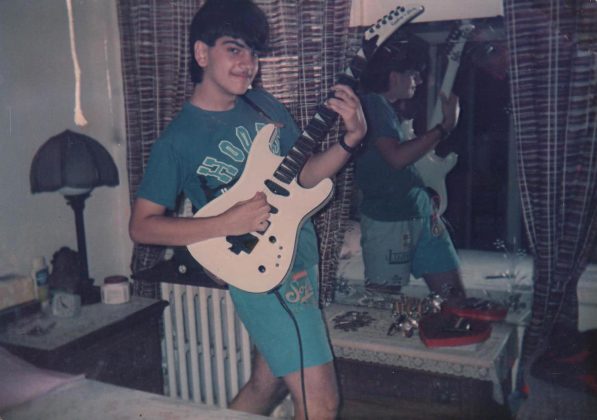- The Brothers Gerazounis: Engineering the Lifeblood of Buildings
- The Hellenic Initiative Summer Youth Academy Empowers Underprivileged Children Through Sports
- CAPTAIN MARIANTHI KASDAGLI: Charting her own course at sea
- Oscar nominee Lorraine Bracco of ‘Goodfellas’ is having ‘More Fun’ than ever before
- Voice And Vision: Grigoris Maninakis, 50 Years Of Greek Music In America
The House of Stathopoulo and Epiphone: The Greeks that Helped Pioneer the Modern Electric Guitar
by Billy Chrissochos
When the two inventors/scientists Serbian-American Nikola Tesla and American Thomas Edison began harnessing and transmitting electricity in the 1880s, they paved the way for a myriad of possibilities for humanity; like electrifying and amplifying sound and eventually music. The first practical prominent device that could be amplified was the triode vacuum tube, invented in 1906 by Lee De Forest, which led to the first amplifiers around 1912. They would be eventually replaced by transistors half a century later. And then someone dreamt of plugging a guitar directly into an amp! Imagine plugging into an electric guitar and strumming a thunderous power chord literally electrifying your audience with the passionate energy you put out. That is the power of the electric guitar!

My own background with the instrument
My own connection to the instrument starts around sixth grade. I fiddled with a junior acoustic guitar on the insistence of my father. His dad (my grandfather) was a famous bouzouki guitarist in the early 1900s in Piraeus, and he wanted me to take up the instrument since I carried his name. I ended up picking up the Alto saxophone instead in Middle School and High School, excelling and competing in Symphony Band. I found the acoustic guitar boring and annoying. And all that tuning you had to constantly do. See, the cheaper the model, the more these instruments get untuned on you making playing not fun.
In the summer of 1990 at the age of fifteen, I worked with my dad in one of his hot dog pushcarts as a sort of first summer job. He had three and rented out the other two. It was fun working with him and a great bonding experience. I worked in Jamaica, Queens at first, and later in midtown Manhattan. I wanted to raise money to get a proper electric guitar. I had caught the metal bug by then, Guns N’ Roses, Iron Maiden, Scorpions, etc.
Somewhere around my junior year in High School, I joined the Jazz-Rock Band which was really a Hard Rock/Metal-inspired outfit in disguise. They played Hendrix, Clapton and of course Nirvana and Guns N’ Roses. The sax could only take me so far. I needed a guitar and amp fast to get the girls and of course, create my own historical musical epics.

Hot dogs and Music Row
Working that summer, I discovered the famous musical instrument strip where Sam Ash and Manny’s Guitars is on Avenue of the Americas (between 7th & 8th avenues) and W48th street. I worked the Hot Dog pushcart up the block so every day I would go out to hang out and try out guitars. I struck up a conversation with the manager and told her I wanted to buy a beginner’s electric guitar. She was really cool and helpful. She, to my surprise, went up to the attic and brought me down a beautiful white solid bodied axe (that is word lingo for guitar).

Young Billy Chrissochos with his Epiphone
It was marked down from last Christmas, and she gave me a super discount. I don’t remember if it was like $100 or $250. It was practically free. And I didn’t sell much hot dogs, sausages, knishes, or pretzels either that summer because I basically ate all the profits, so this was a heaven-sent deal. The guitar was unusual. It was a solid body beautiful white guitar as I stated earlier. A solid body means it was made from a single piece of wood, not two where the head and body are screwed together. So, it was pretty and “sexy” too. It was an Epiphone by Gibson guitar model.
I knew what a Gibson was, but Epiphone sounded so Greek. I was always proud of it, and it helped me create my first group called Phoenix, later Phoenix Reign. I always wondered what was behind the name. So here is the scoop behind my first obsession!
Contrary to what some people might think, Epiphone is not one of the newer companies like Ibanez, Fender, B.C. Rich, or Jackson. In fact, quite the opposite! The history of the (current) Gibson subsidiary goes back to the 19th century. Epiphone has been one of America’s oldest and most revered instrument makers. Since 1873, The name Epiphone evokes both history and the spirit of invention.

The House of Stathopoulo
The Epiphone founding father Anastasios Stathopoulo began to build various stringed instruments as early as 1873. Back then, however, no guitars, but lutes, violins, and traditional Greek instruments such as the bouzouki. Just to put into context the other legendary competitor, Orville Gibson, started making instruments in 1894 and founded the company in 1902 as the Gibson Mandolin-Guitar Mfg. Co. Ltd. in Kalamazoo, Michigan, to make mandolin-family instruments.
Epiphone and the “House of Stathopoulo” has played a central role in every great musical era from the mandolin craze of the early 1900’s to jazz age guitars of the 1920’s; from swing era archtops through post-war pop, jazz, r&b, and early rock n’ roll; and from the “British Invasion” to heavy metal, punk, grunge, and thrash.
The opening chapter of the Epiphone story begins about 149 years ago in Kastania in the mountains overlooking the ancient city of Sparta, Greece. Family legend tells that in 1865, Kostantinos Stathopoulo left Kastania and journeyed to Magoula in the Eurotas valley to register the birth of his son, Anastasios. Little else is known of the family until 1873, around the time of Anastasios’s 12th birthday, when the Stathopoulo family left Greece for the coast of Asia Minor (modern-day Turkey) where they settled in Smyrna, a bustling seaport with a strong Greek population of merchants and craftsmen.
There, Kostantinos established himself as a lumber merchant. Kostantinos would often take Anastasios with him on work trips throughout Europe, where the boy observed his father’s trade and learned about tonewoods. During this time, the family established a store in Smyrna selling and repairing lutes, violins, and bouzoukis. By 1890, Anastasio’s local reputation as a talented, master luthier was providing enough business that he opened his own instrument factory. He married and started a family. His first son, Epaminondas, was born in 1893, followed by Alex, Minnie, Orpheu, Frixo and Ellie.

Tough times ahead
The Hamidian massacres, also called the Armenian massacres, were massacres of Armenians and other Christians such as Greeks and Assyrians, in the Ottoman Empire between 1894-1897. This is the beginning of the greater Thirty-Year Genocide of Christians that ends in 1924. This would also displace another legendary Armenian Cymbal-making family as well, the Zildjians. That is another story though. Another event that would influence the Stathopoulo family would have been the Greco-Turkish War of 1897 known in Greece as the Black ’97 fought between the Kingdom of Greece and the Ottoman Empire.
The immediate cause involved the status of the Ottoman province of Crete, whose Greek-majority population had long desired union with Greece. Despite the Ottoman victory on the field, an autonomous Cretan State under Ottoman suzerainty was established the following year. This was a result of the intervention of the Great Powers after the war. The war put the military and political personnel of Greece to test in an official open war for the first time since the Greek War of Independence in 1821. For the Ottoman Empire, this was also the first war effort to test a re-organized military system.
These were dangerous times and crippled by High taxes imposed on Greek immigrants under the Ottoman Empire made life difficult for the Stathopoulo family and at the age of 40, Anastasios boarded a ship to the United States. Going back to the Greek mainland would have been disastrous economically for them. The Macedonian Struggle (aim to liberate northern Greece from the Ottomans) and National Schism (conflict between Venizelists and Monarchists) leading up to the Great War, between 1904-1922, would engulf Greece. In 1922, Smyrna would be destroyed and burned to the ground by the Turks. Anastasios saw the writing on the wall early on and sought asylum for his family in the United States.

America, America…
First, they settled in Queens’ Astoria/LIC setting up shop at 35-37M 36th Street. Later Public records from 1904 list A. Stathopoulo living at 56 Roosevelt on Manhattan’s Lower East side, home to many other Greek and Italian immigrants. Once in America, Anastasios continued his instrument trade. He quickly assimilated the pace of American business practices. He filed his first and only patent on March 25, 1909, for an Italian-style bowl back mandolin. The “Stathopoulo House” as Epi’s Manhattan showroom was known, was a gathering place for the best musicians in the Big Apple.
Epi, as the oldest child was known, easily merged into American life, attended Columbia University, and graduated with honors. With Anastasios crafting and selling his instruments on the ground floor and his family living upstairs, the line between work and home life became increasingly blurred. Epi and Orpheus (‘Orphie’) were soon helping out in the shop, now located at 247 West 42nd Street.
Epi was only 22 when his father Anastasios died in 1915. As the oldest son, he was charged with keeping the business going. Already a keen student of his father’s work and eager to establish himself in the marketplace, he replaced the old instrument label of his father with a new one: “The House of Stathopoulo, Quality Instruments Since 1873.” Already an amateur designer and inventor during his apprenticeship, Epi now took a lead role in the company and was granted his first patent for a banjo tone ring and rim construction – 1,248,196 given to E. A. Stathopoulo.
At his mother’s death in 1923, Epi assumed ownership of the controlling shares of the business and phased out most of the old-world style mandolins. Instead, he introduced the Recording line of banjos, then the most popular instrument in post-World War I America.
The Recording line was listed in advertisements alphabetically: Recording (A) at $125, the Bandmaster at $200, the Concert at $275, and the De Luxe, which sold for $350. Epi continued to expand as his business and reputation for quality work grew. The family acquired the “stock, goodwill, and modern machinery” of the Farovan Company instrument plant in Long Island and incorporated. Epi gave the now growing business a new name–Epiphone. “Epiphone” referenced not only his own name but the Greek word for sound–phone. It was also an echo of the Greek word epiphonous, meaning one sound on another, the son building on the dreams of the father.
Epi took the title of president and general manager and announced in trade publications and advertisements that “the new policy of business and all interest will be devoted to the production of banjos, tenor banjos, banjo mandolins, banjo guitars, and banjo ukuleles under the registered trademark name of ‘Epiphone.'” Epi retained most of the Long Island factory’s skilled workers. Production increased. Quality improved. One popular guitar model was even called “The Spartan Satin Blonde,” a nod to their proud Peloponnesian roots.
By the mid-‘30s, Epiphone guitars were among the best in the world, and Epi himself was enjoying the patronage of the most respected players on the scene. Epiphone went inter-continental with a distribution deal with Handcraft Ltd. of London, and a new showroom opened at 142 West 14th Street in a seven-story beaux-arts style building near Little Italy.
The new building included an advertised “state-of-the-art” research and development laboratory. The Epiphone showroom on the first floor was both the company’s headquarters and a hangout for musicians. On Saturday afternoons, Epi would open display cases and let the leading guitarists of the time, artists like Al Caiola, Harry Volpe, and Les Paul, jam as people listened by the sidewalk.

Early Epiphone Electric Guitar: The Electar Series
In 1935, Epiphone announced their first electric guitars with the “Electar” models (originally known as Electraphone). These were based heavily on the first Rickenbacker guitars from 1932. Initially, large magnetic blocks were used as pickups, which as a rule did not really transmit the sound of the individual strings evenly. To prevent this problem, Epiphone introduced the “Master Pickup” in 1937 – the world’s first pickup with individually adjustable pole pieces.
In addition to the newly developed pickup, a first, fairly simple, tone control was also introduced. And in the same year, the famous Frequensator Tailpiece was created, which is still widely used today and has had a lasting influence on the designs of many other companies.

Incursion into amplifiers
Epiphone also began selling amps after meeting electronics enthusiast Nat Daniel, a friend of Les Paul. Daniel perfected an innovative push / pull cabling design, which is now an accessory on many amplifiers. Epiphone reps listened to Daniel’s amps and adhered to him to build chassis and new designs. Years later, in the ‘50s Daniel would start the Danelectro line of guitars and amplifiers in the ’50s.
Epi’s death and the consequences for Epiphone
During the Second World War (June 6, 1943) Epaminondas died of leukemia. As a result, his two little brothers, Orphie and Frixo, took over the company. Orphie eventually sold the company in the fifties to Gibson. In 1957, Gibson finally took over Epiphone and re-introduced the line and a new era emerged. Epiphone through Gibson is stronger than ever and the legacy of the House of Stathopoulo lives on.

List of famous Epiphone players
Epiphone was one of the biggest brands in the early acoustic and electric guitar years in America. Along with Gibson, they were the most recognized and coveted brands of guitars. The variety of musicians that traverse the history of Epiphone is remarkable and extensive. Jazz greats like George Van Eps, country pioneers like Hank Garland, bluesman John Lee Hooker, and scores of mandolins, archtop, and steel guitar players used Epiphone instruments daily over nationwide broadcasts. There are unlikely heroes and tinkerers in the Epiphone story too, like guitar pioneer Les Paul, who worked nights in the Epiphone factory in New York City to create “the Log”, his primordial version of what would eventually be called the “Les Paul.” Another notable player is Django Reinhart.
The Beatles’ bassist extraordinaire Paul McCartney chose an Epiphone Casino as his first American-made guitar and John Lennon and George Harrison quickly followed. The Casino appeared on every Beatles album from Help through Abbey Road. The Peter Frampton Les Paul Custom was used in Frampton Comes Alive which is among the best-selling live records in history, and even today many of the tracks are staples of classic rock radio. Keith Richards also used a Casino and Blues great B.B. King used a signature model in the eighties.
And today, Epiphone can be heard on albums by Gary Clark, Jr., Alabama Shakes, My Chemical Romance, Joe Bonamassa, Nirvana, Johnny Winter, Zakk Wylde, Machine Head, Dwight Yoakam, The Strokes, Trent Reznor, Slash, Jeff Waters, Paul Simon, Radiohead, The Waco Brothers, Lenny Kravitz, Nancy Wilson, and Paul Weller. And many more metal guitarists from Trivium and In Flames, to Tommy Thayer, Mathias Jabs from Scorpions, Tony Iommi, Alex Lifeson from Rush, Twister Sister’s Jay Jay French, Ace Frehley from Kiss, Richie Faulkner from Judas Priest also use Epiphone models.
The story behind Epiphone’s improbable rise from a small Greek family repair shop to a worldwide leader in the manufacture of quality instruments could easily be transformed into the great American novel. But this story is true. The Ottoman Empire’s loss was America’s musical gain.
Who knows? Perhaps my own grandfather jammed at some point with Anastasios. What I do know is that this guitar influenced my life. I even created a Rock Opera that premiered at Carnegie Hall and Off-Broadway called “Anna and Vladimir.” A historical Byzantine epic!
All inspired by that first power chord and lots of practice, practice, practice!
I am also excited to share news of our new Rock Opera! It will be presented by St. Demetrios Preparatory School for the kids and the community. It is called, “The Story of Princess Anna Porphyrogenita,” and it is a thrilling, historical, cultural journey through Music, Dance, and Theater.

Set in the year 988 AD, the Heroic Age of Basil II Emperor of Byzantium, the story chronicles Basil’s sister Princess Anna Porphyrogenita and her world-rocking marriage to Grand Prince Vladimir. The show also explores Penelope Delta’s incredible world, as envisioned by the great author, of Emperor Basil II’s Byzantine Greek Macedonian Renaissance, his struggles, victories, and aspirations for his people and family.
This is a Fundraiser for St. Demetrios Preparatory School and all its wonderful programs. The show is running for three dates.
June 24th, Friday at 7:00 PM, June 25th, Saturday at 7:00 PM, June 26th, Sunday at 5:00 PM. Admission is $35
You can learn more about our Rock Opera and not-profit here http://porphyrafoundation.org/rock-opera/
Presented by:
https://www.patreon.com/HellenicHistorySeries
And LIKE our Facebook page: https://www.facebook.com/HellenicHistorySeries
Also, subscribe to Hellenic History Series Youtube Channel: https://www.youtube.com/user/kalavrita1821/videos
Please make sure you subscribe to Porphyra https://youtube.com/user/PorphyraOfficial
On Facebook https://www.facebook.com/PorphyraBand/
Website: https://porphyraband.com











0 comments